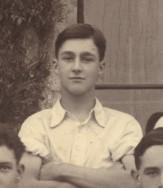
|

|
| Pilot Officer Eric James WATSON | |
|
25 Squadron, Royal Air Force Date of birth: 7th November 1906 Date of death: 17th February 1928 Killed on active service aged 21 Buried at Elmers End Cemetery |

|
| Eric James Watson was born in Siam on the 7th of November 1906 the elder son of C. L. Watson, Legal Adviser to the Civil Court at the Ministry of Justice in Siam. He was educated at Lancing College where he was in Sandersons House from September 1920 to December 1923. He attended the Royal Air Force College, Cranwell from January 1925 to July 1930 from where he was commissioned as a Pilot Officer in the Royal Air Force on the 30th of July 1927 and was posted to 25 Squadron based at Hawkinge airfield in Kent. On the 17th of February 1928 he took off from RAF Hawkinge in a Gloucester Grebe aircraft for a practice combat exercise with Flying Officer Leonard Arthur Walsh from the same squadron. At 2.24 pm, while flying at a height of 1,000 feet, the wing of Watson's aircraft collided with the tail section of Walsh's aircraft, destroying it and causing both aircraft to become uncontrollable. Both airmen bailed out of their stricken aircraft with Walsh opening his parachute at about 1,000 feet. He drifted for nearly half a mile before his parachute become entangled in some telephone lines on the Dover side of Capel Street, near Folkestone. He was rescued by some men who were working nearby and was taken to the Royal Oak public house in a state of shock. Eric Watson did not manage to open his parachute until he was very near to the ground and it didn’t fully deploy. He was badly injured by the fall and was taken to Shorncliffe Hospital where he died from his injuries an hour later. The two aircraft were destroyed when they came down near Cauldham Farm. An inquest was held at RAF Hawkinge on the 20th of February 1928 which noted that Watson's parachute was torn, most probably from his being too close to the aircraft when it opened. In his evidence to the inquiry Flying Officer Walsh said:- “On Friday afternoon I told Pilot Officer Watson to do individual combat with me. I was his senior. We both went up and practised getting into position. When we were just over 2,000 ft. up he attacked me three times. After that he broke away, and I saw him about a mile away from me. To enable him to catch me I throttled my engine back to 1,000 revolutions and flew straight and level towards Dover. The next thing, I looked round and saw a pair of planes in a vertical bank turning into me on the starboard side. Then I felt the impact and my machine went out of control. My wings were not damaged but the tail of my plane was cut off. When I realised the position I did my best to get out of the seat in my machine. I succeeded. When I got out of the machine I counted eight and then pulled my rip cord. My parachute immediately opened and acted well. Owing to the strong north wind I was blown towards the sea. By "spilling" air, however I managed to come down on some telegraph wires some 20 yards from the edge of the cliff on the main Dover-Folkestone road. A civilian helped me down to the road." A verdict of misadventure was returned. His funeral was held at 11.15am on the 22nd of February 1928. |
|
| Sandersons House |
Back